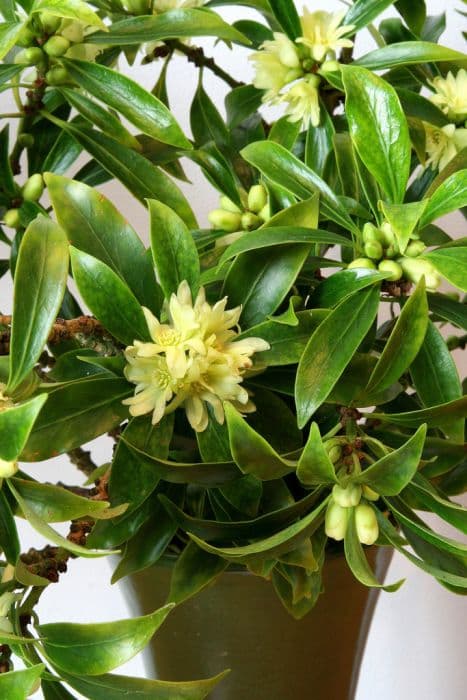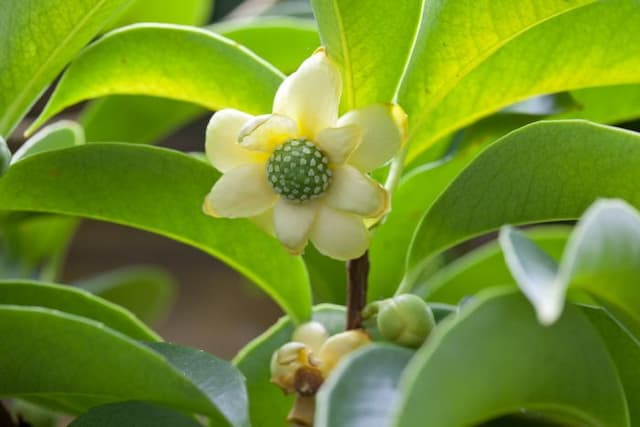Nan Wu Wei Zi Schisandra sphenanthera

ABOUT
Schisandra sphenanthera, commonly known as South China schisandra, is a climbing plant adorned with a striking interplay of leaves, flowers, and fruits. The leaves are simple, broad, and display a gleaming green hue that can capture the gentlest of light within its surroundings. Arranged alternately along the vine, each leaf embraces an oval shape with a pointy tip, creating a delicate yet resilient foliage display. As spring warms into early summer, the South China schisandra graces the air with small, unassuming flowers. The male and female flowers are typically found on separate plants. The petals of these flowers tend to vary in color from white to pale yellow, sometimes with a hint of pink, and curl slightly at their edges, adding a soft, subtle beauty that complements the verdant leaves. These dainty flowers are often clustered together, emerging from the leaf axils. Furthermore, the plant's allure grows with the appearance of its berries. These are presented in dangling bunches that may remind one of miniature grapes. Each glossy berry is a bold red that stands out against the greenery, enticing to both the eyes of onlookers and the appetite of various bird species. Although the appearance of plant parts such as leaves, flowers, and fruits can vary slightly depending on environmental conditions, this general description captures the essence of Schisandra sphenanthera's visual charm.
About this plant
 Names
NamesFamily
Schisandraceae
Synonyms
Southern Schisandra, Five-flavor Berry, Nan Wu Wei Zi
Common names
Kadsura sphenanthera, Maximowiczia chinensis, Schisandra chinensis var. rubriflora, Schisandra rubriflora, Schisandra sphenanthera var. rubriflora.
 Toxicity
ToxicityTo humans
Schisandra sphenanthera, commonly known as five-flavor berry, is not generally considered toxic to humans. In traditional medicine, it is actually used for its various health benefits. As with any supplement, however, it is possible that some individuals might experience adverse reactions, particularly if consumed in excessive amounts. These side effects could include upset stomach, heartburn, or allergic reactions. Always consult with a healthcare provider before using Schisandra sphenanthera as a supplement, especially if you are pregnant, breastfeeding, or have underlying health conditions.
To pets
Five-flavor berry is not typically recognized as being toxic to pets. However, individual animals might have sensitivities or allergic reactions to plants that are not commonly toxic. Signs of an adverse reaction could include gastrointestinal upset, such as vomiting or diarrhea. If a pet ingests a large quantity of any non-food plant, including five-flavor berry, it's wise to monitor for any unusual symptoms and consult with a veterinarian if any concerns arise.
 Characteristics
CharacteristicsLife cycle
Perennials
Foliage type
Deciduous
Color of leaves
Green
Flower color
Red
Height
20 feet (6 meters)
Spread
6 feet (2 meters)
Plant type
Climber
Hardiness zones
4
Native area
China
Benefits
 General Benefits
General Benefits- Adaptogenic Properties: Schisandra sphenanthera is known to help the body resist stressors of all kinds, whether physical, chemical or biological.
- Enhances Physical Performance: It may help improve endurance and mental performance,
- Supports Liver Function: The plant is believed to have hepatoprotective effects, which means it can protect the liver.
- Anti-Aging Effects: It contains antioxidants which are thought to have anti-aging benefits for the skin.
- Improves Concentration: Schisandra may enhance concentration, focus, and coordination.
- Stimulates the Nervous System: It can have a stimulating effect on the nervous system, increasing alertness.
- Supports Skin Health: Its antioxidant properties may contribute to healthier skin appearance.
- Enhances Detoxification: Schisandra is thought to promote the detoxifying functions of the liver, helping to cleanse the body of harmful toxins.
- Reduces Fatigue: It can help combat fatigue and increase energy levels at a cellular level.
- Culinary Uses: Schisandra berries are also used to make juices, wines, extracts, and sweet treats, contributing to dietary variety.
- Traditional Practices: It is employed in various traditional practices for its overall health-boosting properties.
 Medical Properties
Medical Properties- Adaptogenic properties: Schisandra sphenanthera is known to help the body resist stressors of all kinds, both physical and emotional.
- Hepatoprotective effects: It is believed to protect the liver from toxins and to support its natural regenerative ability.
- Antioxidant activities: The plant contains compounds that may combat oxidative stress and improve overall cellular health.
- Improving mental performance: Some components of Schisandra sphenanthera might enhance concentration, attention, and speed of thinking.
- Stimulating the immune system: It may bolster the immune response, helping the body to fight off infections.
- Anti-inflammatory properties: The plant can potentially reduce inflammation, which is linked to many chronic diseases.
- Antitussive effects: It has traditionally been used to help relieve coughing.
- Anti-asthmatic potential: Components of Schisandra sphenanthera might benefit patients with asthma.
- Endurance enhancing: It is sometimes used to improve endurance and physical performance.
- Anticancer potential: Some research suggests that Schisandra sphenanthera could have anti-tumor effects.
- Enhancing sexual function: The plant has a history of use in improving sexual stamina and preventing premature ejaculation.
 Air-purifying Qualities
Air-purifying QualitiesThis plant is not specifically known for air purifying qualities.
 Other Uses
Other Uses- Schisandra berries are sometimes employed as a natural dye, providing a range of color shades from pink to purple depending on the mordant used.
- In some traditions, Schisandra berries are used in rituals and ceremonies as symbols of longevity and vitality.
- The wood from Schisandra vines is occasionally carved into small trinkets and jewelry, appreciated for its fine grain and workability.
- The aromatic properties of Schisandra berries make them a potential ingredient in homemade potpourris and scented sachets.
- Schisandra berry extract can be used as an ingredient in natural cosmetic products like creams and balms for its fragrance and color.
- The crushed berries are sometimes integrated into candles to add a natural fragrance as they burn.
- Schisandra berries have been used to flavor certain liquors and fermented beverages in craft infusions, providing a unique, tangy taste.
- In artisanal food preparation, the berries might be used as a flavoring agent for jellies, jams, or syrups.
- The seeds of Schisandra may be used in the creation of botanical artworks or mixed-media collage art as a natural element.
- As a plant that can adapt to various light conditions, Schisandra can be cultivated indoors for ornamental purposes to add greenery to living spaces.
Interesting Facts
 Feng Shui
Feng ShuiSchisandra is not used in Feng Shui practice.
 Zodiac Sign Compitability
Zodiac Sign CompitabilitySchisandra is not used in astrology practice.
 Plant Symbolism
Plant Symbolism- Vitality: Schisandra, often referred to as Wu Wei Zi, is known for its restorative qualities, symbolizing vitality and the energy required to adapt to life's stressors.
- Balance: With its combination of sweet, sour, bitter, warm, and salty flavors, Schisandra represents the harmony of the five basic flavors in traditional Chinese medicine, symbolizing the body's balance and overall well-being.
- Longevity: Schisandra is believed to promote longevity, symbolizing the aspiration for a long and healthy life.
- Mental Clarity: Due to its purported effects on enhancing mental performance and concentration, Schisandra symbolizes clarity of thought and improved focus.
- Healing: Its role in traditional medicine as a tonic for various ailments makes Schisandra a symbol for healing and recovery.
 Water
WaterThe Five-Flavor Fruit requires consistent moisture, so it's crucial to water it thoroughly whenever the top inch of soil feels dry to the touch. Typically, this might mean watering every week, but this can vary depending on climate and soil conditions. When watering, add approximately 1 to 2 gallons of water to the base of the plant to ensure the root zone is adequately saturated. Avoid overhead watering to prevent fungal diseases. During the growing season, especially in hot or windy weather, you might have to water more frequently to maintain consistent soil moisture.
 Light
LightThe Five-Flavor Fruit thrives best in partial shade to full sun. An ideal spot would be somewhere that receives morning sunlight and is protected from the harsh afternoon sun, or a location that gets dappled sunlight throughout the day. Ensure the plant is placed where it can receive at least 4 to 6 hours of sunlight daily for optimal growth.
 Temperature
TemperatureThe Five-Flavor Fruit performs well in a temperature range between 60°F and 80°F. They can withstand temperatures as low as 0°F but shouldn't be exposed to such extremes for prolonged periods. The ideal temperature conditions for flourishing growth fall within the range of 70°F to 75°F.
 Pruning
PruningPruning the Five-Flavor Fruit is mainly done to maintain shape, remove dead or damaged branches, and encourage healthy growth. It is best to prune in late winter or early spring before new growth begins. Cut back any unwanted branches by one-third of their length, and remove any weak or diseased growth completely. Pruning should be done sparingly, as excessive cutting can reduce the plant's yield.
 Cleaning
CleaningAs needed
 Soil
SoilFor the Five-Flavor Fruit, a well-draining soil mix with rich organic matter is ideal. The soil should be slightly acidic to neutral, with a pH range of 5.5 to 7.0. A mixture of loam, peat, and sand or perlite can help achieve these conditions, providing good aeration and moisture retention for healthy growth.
 Repotting
RepottingFive-Flavor Fruit should be repotted every 2 to 3 years to ensure healthy growth. Younger plants may benefit from more frequent repotting, but as they mature, repotting can be done less often. It's important to use fresh soil and a slightly larger pot during each repotting.
 Humidity & Misting
Humidity & MistingThe Five-Flavor Fruit thrives in high humidity environments. It is best to maintain humidity levels between 60% to 80%. In drier conditions, employing a humidifier or regular misting can help meet its humidity requirements for optimal growth.
 Suitable locations
Suitable locationsIndoor
Ensure bright indirect light and high humidity for the Five-Flavor Fruit.
Outdoor
Plant the Five-Flavor Fruit in partial shade with moist soil.
Hardiness zone
4-8 USDA
 Life cycle
Life cycleSchisandra sphenanthera, commonly known as the Five-Flavor Berry, begins its life as a seed which requires stratification to break dormancy. After germination, the seedling establishes itself, developing a root system and foliage. As it grows into a mature vine, it produces clusters of flowers which are typically unisexual, meaning that male and female flowers are found on separate plants. Pollination is achieved often by wind or insects, leading to the formation of small, red berries if the flowers are successfully fertilized. Each berry contains several seeds, which can be dispersed by birds and animals, thus beginning the cycle anew. The plant continues to grow and can live for many years, flowering and fruiting annually once maturity is reached.
 Propogation
PropogationPropogation time
Spring-Early Summer
Propogation: Schisandra sphenanthera, commonly known as Five-Flavor-Fruit, is typically propagated by seed. The most popular method involves collecting ripe berries in the fall, extracting the seeds, and sowing them either directly outdoors or in a cold frame after stratification. Stratification is a process where seeds are subjected to a period of cold to break dormancy and can be accomplished by mixing the seeds with moist sand and storing them in a refrigerator for about 90 to 120 days. Upon removal from stratification, seeds are sown in a well-draining soil mix, barely covered with soil, and kept at a temperature of 68 to 86 degrees Fahrenheit (20 to 30 degrees Celsius). Germination can be slow and irregular, often taking several months. Once seedlings are large enough to handle, they are transplanted to individual pots and grown on until they are ready to be planted out in their permanent position.


